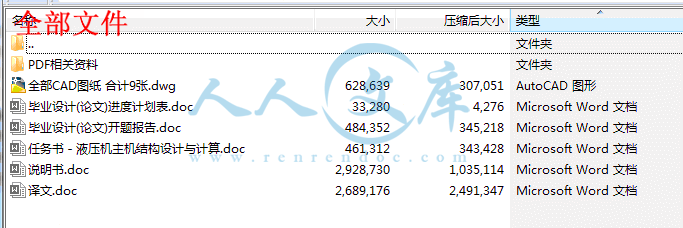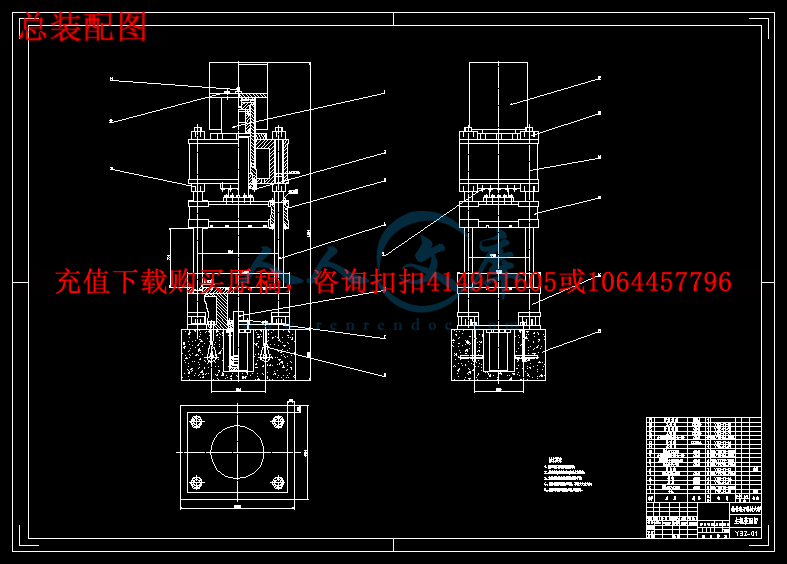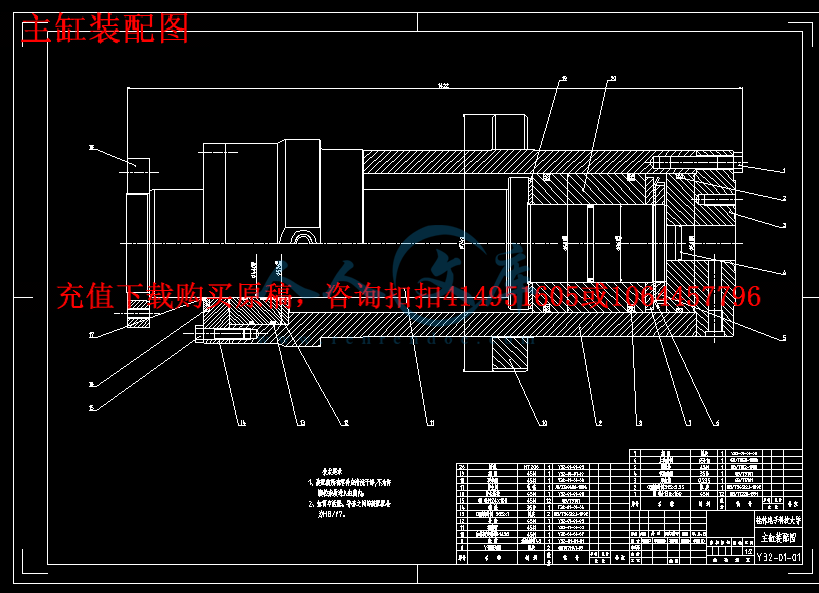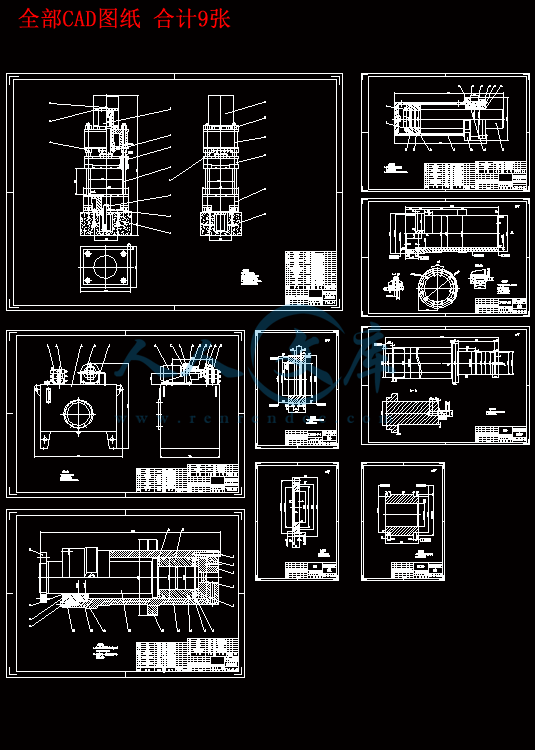【温馨提示】 购买原稿文件请充值后自助下载。
以下预览截图到的都有源文件,图纸是CAD,文档是WORD,下载后即可获得。
预览截图请勿抄袭,原稿文件完整清晰,无水印,可编辑。
有疑问可以咨询QQ:414951605或1304139763
摘 要
根据任务书的要求,在设计前查阅了相关资料,了解了四柱式通用液压机的工作原理、设计过程,设计了一台四柱式通用液压机的主机部分。通过工作要求计算出液压机的主要技术规格,进行多种四柱式液压机的方案论证比较,选出了最优设计方案。根据最优方案,依次设计完成了液压系统、主机结构和泵站的设计计算。
液压机主缸是液压机的主要工作部件,液压机主缸的性能直接影响着液压机整体工艺水平。通过细致的分析及理论研究解决易损部分设计结构中存在的问题,可以使液压缸整体上达到工艺强度要求,提高液压缸应用的工艺水准及使用寿命。所以对液压机主缸进行细致严谨的设计计算对对液压机的设计生产有着至关重要的作用。
本论文从总体上对液压机本体结构,主要结构部件进行设计及必要的校核,对液压机主缸主要参数进行计算,并对所得结果进行分析、验算,从而力争使液压机主缸能够满足生产工艺要求,并从整体上提高液压机的工艺水准,使液压机设计水平更上一个新的台阶。
关键词:液压机;结构设计;液压缸
Abstract
According to the mission statement of requirements before designing the access to relevant information, to understand the working principle of universal four-column hydraulic machine, the design process, the design of a common host part of a four-post hydraulic press. Through the work required to calculate the main technical specifications of hydraulic machines, for a variety of four-column hydraulic machine demonstration program compares to elect the optimal design. According to the optimal solution, in order to complete the design of the hydraulic system, the host structure and pumping station design calculations.
Hydraulic master cylinder is the main working parts of hydraulic press, hydraulic press master cylinder direct impact on the performance of the overall technological level of hydraulic machines. Through careful analysis and theory to solve the structure vulnerable part of the design problems in it , and the hydraulic cylinder can be reached technological strength of the overall requirements of the application of technology to improve the standard of the hydraulic cylinder and life. So the cylinder for hydraulic design of meticulous
calculation of the design and production of hydraulic machines has a vital role.
This paper generally focus on the body structure of the hydraulic press, and design the major structural components and its necessary check , calculation of the main parameters of the hydraulic master cylinder, and analysis and checking the results. To strive to make the hydraulic master cylinder to meet the requirements of production press and raise the overall technological level of the hydraulic press, and hydraulic press design level to advance to a new level.
Keywords: Hydraulic press;Structural Design;Hydraulic cylinder
目 录
引言1
1 液压机的基本知识2
1.1 概述2
1.2 液压机的型号和主要技术规格3
1.2.1液压机的型号3
1.2.2液压机的主要技术规格3
1.3 液压机的分类5
1.4 液压机的发展概况5
2 四柱式通用液压机总体方案设计6
2.1 四柱式通用液压机的工作原理和动作循环分析6
2.1.1四柱式液压机的工作原理分析6
2.1.2四柱式液压机的动作顺序分析6
2.1.3四柱式液压机的工作循环分析7
2.2 主要技术规格的确定7
2.3 四柱式通用液压机的总体设计9
2.3.1四柱式液压机各部分的方案选择9
2.3.2总体布局设计9
3 四柱式液压机液压系统与电气系统设计10
3.1 液压系统设计10
3.1.1液压传动概述10
3.1.2液压系统设计参数10
3.1.3液压系统原理图的拟定11
3.1.4液压系统控制过程分析12
3.1.5液压元件的选择13
3.2 电气系统设计13
4 液压机主机结构设计与校核14
4.1 液压缸部件的设计与校核14
4.1.1液压缸的结构形式及方案论证比较14
4.1.2液压缸的支承形式及方案论证比较15
4.1.3柱塞与活动横粱的连接形式与方案论证比较16
4.1.4 液压缸基本尺寸计算16
4.1.5缸体强度计算17
4.2 顶出缸部件的设计与校核20
4.2.1顶出缸的尺寸计算20
4.2.2活塞杆稳定性的校核21
4.3 上横梁的设计与校核21
4.3.1上横梁结构形式及方案论证比较21
4.3.2上横梁的尺寸计算22
4.3.3上横梁的强度计算23
4.3.4上横梁的刚度计算23
4.4 工作台的设计与校核24
4.4.1工作台的结构形式与方案论证比较24
4.4.2工作台的尺寸计算24
4.4.3工作台的强度计算25
4.4.4工作台的刚度计算25
4.5 立柱组件的设计与校核26
4.5.1立柱的连接形式与方案论证比较26
4.5.2立柱的尺寸设计26
4.5.3立柱的强度校核27
4.5.4立柱螺母及预紧27
4.5.5立柱螺母的强度校核28
4.6 活动横梁的设计29
4.6.1活动横梁的结构设计29
4.6.2活动横梁尺寸设计29
4.7 主机其他部件设计30
4.7.1立柱导套30
4.7.2限程套30
4.8 主机总体结构设计31
5 液压机动力系统的设计与计算32
5.1 液压泵的计算与选择32
5.1.1液压泵最高工作压力的计算32
5.1.2液压泵最大流量计算32
5.1.3选择液压泵的规格33
5.2 电动机的选择33
5.3 油箱的设计与计算33
5.3.1油箱有效容积的确定33
5.3.2油箱的结构设计34
5.4 油管的设计与计算34
5.4.1主油缸油管内径计算35
5.4.2顶出缸油管内径计算35
5.5 泵站设备的布置36
5.5.1泵站设计应考虑的问题36
5.5.2泵站的结构形式设计36
6 四柱液压机安装调试和维护37
6.1 四柱液压机的安装37
6.2 四柱液压机的调试37
6.3 四柱液压机的保养维护38
7 结论38
谢辞39
参考文献40
附录41
引言
作为机械制造行业中一种重要的生产设备,锻压设备己广泛地应用于工业生产的各个领域。液压机作为一种通用的锻压设备,主要是利用液压传动技术实现各种压力加工工艺,具有功率大、精度高、规格多的特点。因此在锻压 (塑性加工)领域中,液压机被广泛应用于自由锻造、模锻、冲压(板料成形)、 挤压、剪切、拉拔成形及超塑性成形等工艺中。
本设计着重叙述了液压机的泵站、液压机的本体结构及设计计算以及液压机液压系统的设计三个方面,里面详细的说明了液压机的基本工作原理、特点、分类、基本参数、液压机的本体结构及其设计计算以及液压机的液压系统的设计,尤其主液压缸的设计与校核阐述了大量内容。
设计液压机的意义在于其不但具有较大的通用性,适用于塑性材料的成形如簿板件的落料、拉伸、压印等;轴类件的校正;零部件的压装;粉末制品的压制。还具有点动、手动和半自动等操作方式,可按工艺需要任选定时或定位控制,压力和行程可调,操作灵便、工作可靠。
1 液压机的基本知识
1.1 概论
液压机是根据帕斯卡原理制成,是一种利用液体压力能来传递能量的机器。在国民经济的各个领域都得到广泛的应用,如锻造液压机,模锻液压机、冲压液压机、万能液压机等。它们具有许多优点:如结构简单,结构布局灵活;可以根据工艺要求来灵活改变其压力与行程;可以根据工艺要求十分方便的在各种部位布置所需的液压缸;与机械压力机相比,具有压力和速度可在广泛的范围内无级调速;可在任意位置输出全部功率和保持所需压力;各执行机构动作可很方便地达到所希望的配合关系;振动小、易于实现计算机控制及自动控制等等。所以液压机在国民经济各部门得到了日益广泛的应用。






 川公网安备: 51019002004831号
川公网安备: 51019002004831号